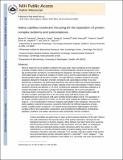| dc.contributor.author | Fonslow, Bryan R. | |
| dc.contributor.author | Kang, Seong A. | |
| dc.contributor.author | Gestaut, Daniel R. | |
| dc.contributor.author | Graczyk, Beth | |
| dc.contributor.author | Davis, Trisha N. | |
| dc.contributor.author | Yates III, John R. | |
| dc.contributor.author | Sabatini, David | |
| dc.date.accessioned | 2012-11-01T16:52:05Z | |
| dc.date.available | 2012-11-01T16:52:05Z | |
| dc.date.issued | 2010-07 | |
| dc.date.submitted | 2010-05 | |
| dc.identifier.issn | 0003-2700 | |
| dc.identifier.issn | 1520-6882 | |
| dc.identifier.uri | http://hdl.handle.net/1721.1/74544 | |
| dc.description | available in PMC 2011 August 1. | en_US |
| dc.description.abstract | Here we report the use of capillary isoelectric focusing under native conditions for the separation of protein complex isoforms and subcomplexes. Using biologically relevant HIS-tag and FLAG-tag purified protein complexes, we demonstrate the separations of protein complex isoforms of the mammalian target of rapamycin complex (mTORC1 and 2) and the subcomplexes and different phosphorylation states of the Dam1 complex. The high efficiency capillary isoelectric focusing separation allowed for resolution of protein complexes and subcomplexes similar in size and biochemical composition. By performing separations with native buffers and reduced temperature (15 °C) we were able to maintain the complex integrity of the more thermolabile mTORC2 during isoelectric focusing and detection (<45 min). Increasing the separation temperature allowed us to monitor dissociation of the Dam1 complex into its subcomplexes (25 °C) and eventually its individual protein components (30 °C). The separation of two different phosphorylation states of the Dam1 complex, generated from an in vitro kinase assay with Mps1 kinase, was straightforward due to the large pI shift upon multiple phosphorylation events. The separation of the protein complex isoforms of mTORC, on the other hand, required the addition of a small pI range (4−6.5) of ampholytes to improve resolution and stability of the complexes. We show that native capillary isoelectric focusing is a powerful method for the difficult separations of large, similar, unstable protein complexes. This method shows potential for differentiation of protein complex isoform and subcomplex compositions, post-translational modifications, architectures, stabilities, equilibria, and relative abundances under biologically relevant conditions. | en_US |
| dc.description.sponsorship | National Institutes of Health (U.S.) (grant R01DK074798) | en_US |
| dc.description.sponsorship | National Institutes of Health (U.S.) (grant P41RR011823) | en_US |
| dc.description.sponsorship | National Institutes of Health (U.S.) (grant R01GM40506) | en_US |
| dc.description.sponsorship | National Institutes of Health (U.S.) (grant R01AI47389) | en_US |
| dc.description.sponsorship | National Institutes of Health (U.S.) (grant R01CA103866) | en_US |
| dc.description.sponsorship | LAM Foundation (Fellowship) | en_US |
| dc.description.sponsorship | American Cancer Society | en_US |
| dc.description.sponsorship | Howard Hughes Medical Institute (Investigator) | en_US |
| dc.description.sponsorship | United States. Dept. of Defense (grant W81XWH-07-1-0448) | en_US |
| dc.language.iso | en_US | |
| dc.publisher | American Chemical Society | en_US |
| dc.relation.isversionof | http://dx.doi.org/10.1021/ac101235k | en_US |
| dc.rights | Article is made available in accordance with the publisher's policy and may be subject to US copyright law. Please refer to the publisher's site for terms of use. | en_US |
| dc.source | PMC | en_US |
| dc.title | Native capillary isoelectric focusing for the separation of protein complex isoforms and subcomplexes | en_US |
| dc.type | Article | en_US |
| dc.identifier.citation | Fonslow, Bryan R. et al. “Native Capillary Isoelectric Focusing for the Separation of Protein Complex Isoforms and Subcomplexes.” Analytical Chemistry 82.15 (2010): 6643–6651. Web. | en_US |
| dc.contributor.department | Massachusetts Institute of Technology. Department of Biology | en_US |
| dc.contributor.department | Whitehead Institute for Biomedical Research | en_US |
| dc.contributor.mitauthor | Sabatini, David M. | |
| dc.relation.journal | Analytical Chemistry | en_US |
| dc.eprint.version | Author's final manuscript | en_US |
| dc.type.uri | http://purl.org/eprint/type/JournalArticle | en_US |
| eprint.status | http://purl.org/eprint/status/PeerReviewed | en_US |
| dspace.orderedauthors | Fonslow, Bryan R.; Kang, Seong A.; Gestaut, Daniel R.; Graczyk, Beth; Davis, Trisha N.; Sabatini, David M.; Yates III, John R. | en |
| dc.identifier.orcid | https://orcid.org/0000-0002-1446-7256 | |
| mit.license | PUBLISHER_POLICY | en_US |
| mit.metadata.status | Complete | |
